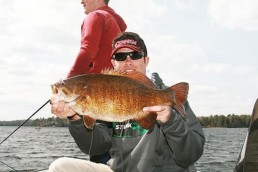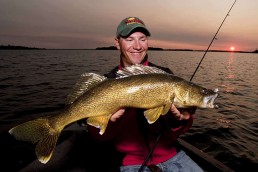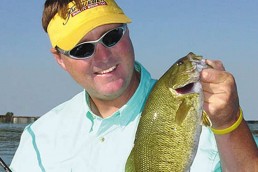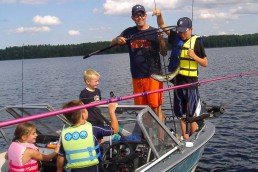Northern Wisconsin Smallmouth Bass Calendar
Where and how to find terrific smallmouth action on the waters of northern Wisconsin
The Northwoods of Wisconsin is my home fishing area, a land of scenic beauty, lots of lakes, and healthy populations of smallmouth bass. My goal here is to help you plan a season of action by paying attention to changes that occur during the open-water season.
When and where
Opportunities abound, and as a part-time Wisconsin resident from May through October I’m lucky to have the luxury of patterning many lakes, gaining knowledge that helps me know where to go in the northern tier of the state.
According to geographic experts, the line of entry into northern Wisconsin is along state Highway 29, which travels horizontally from Hudson to Green Bay. However, my Northwoods map officially begins several miles farther north, with the official gateway located in the Wisconsin River paper mill town of Merrill. Here, the landscape changes from fertile farmland to pine forest.
The entire northern region of Wisconsin and its never-ending fishing destinations runs northward to Lake Superior and the “Yooper” border, then stretches from Green Bay in the east, to the St. Croix River and its formation on the Wisconsin/Minnesota border in the west.
Within this region are several popular fishing towns and destinations. Popular areas are the Great Lakes towns of Ashland and Bayfield on Lake Superior, which offer world-class trout and salmon fishing, along with walleyes and an expanding smallmouth bass fishery. Then to the east, along Lake Michigan, is the Bay of Green Bay, encompassing the towns of Oconto, Green Bay and Sturgeon Bay. This region of the bay and Door County contains some of the best walleye, muskie, and smallmouth bass fishing on the planet.
Moving inland, the fishing gets more challenging, but is still worth your time. In northwest Wisconsin, the region of Hayward, Spooner and Minong is revered for its historic fishing and muskie lore.
Where I live and spend most of my time is in the Minocqua/Woodruff/Lakeland area of Iron, Vilas and Oneida counties. This region boasts almost 4,000 lakes and offers some of the best diversity of lake types and inland fishing that can be experienced in all of Wisconsin.
Early-season smallies
The spring season takes place in May and June, and offers some of the best fishing of the year for all species. Encompassing the pre-spawn to early summer period, all species of fish are on the feed, and in abundance throughout the shallows of most lakes and river systems.
Trophy smallmouths are my primary interest throughout the year. Except for a few distinct summer and fall periods, spring fishing is simply the best. A popular destination is Sturgeon Bay and its surrounding waters. No other place in the world contains as many 4- and 5-pound smallies. Every spring, packs of anglers visit for weekend tournaments, including the popular Sturgeon Bay Open. In the last two “Opens,” fish up to 8.5 pounds have been caught and released, true monsters anywhere in the country. Meanwhile, other anglers schedule weeklong spring vacations at one of the many lakeside resorts and hotels, or hire a top-notch guide like Dale Stroschein or Bret Alexander.
While Sturgeon Bay changes bass anglers’ lives and has the potential to produce a smallmouth world record, I will always prefer fishing the more challenging and diverse inland fisheries, simply because I grew up fishing them, and they have a special place in my heart.
In recent years, I’ve caught hundreds of smallmouths exceeding 18 inches and 4 pounds, with a personal best of 22 inches that weighed about 7 pounds. I am convinced that my inland waters, rich in crayfish and pelagic baitfish, are capable of rearing the next Wisconsin state record, thanks to conservation and superb lake management. In Vilas and Oneida counties alone, I have the joy of choosing from more than 200 trophy smallmouth lakes, all within 40 miles of Minocqua. My region is becoming known as a world-class bass fishing destination. Because each lake fishes differently, and contains different population densities and size structures, I love having the option to fish multiple lakes per day, and shape outings to fit my mood and what methods I want to fish at the moment. Few places in the world outside of southern Ontario and Minnesota have this much bass fishing diversity.
Other inland waters worthy of smallmouth trips are the massive lake chains, Eagle River and Three Lakes, Minocqua Chain (for numbers), Lac du Flambeau chain, and the lakes around Hayward, including Round, Grindstone, and Lac Courte Orielles.
Also, don’t forget to “lake hop” through the many smaller lakes, too, because they can kick out some of the largest fish you will ever catch.
The river systems and flowages are home to some of the most under-fished, fastest growing and fattest smallmouth populations in the state. These waters include the upper Wisconsin River system where my friend Kurt Schultz offers jet boat trips in spring before muskie season opens; the Menominee River outside of Florence where MidWest Outdoors writer Mike Mladenik is revered; the remote St. Croix River from St. Croix Falls to Danbury; and the Turtle-Flambeau Flowage, where I spend considerable time dissecting stump fields and channels. There are hundreds more to recommend, but we have to leave room for your own searching, right?
Summer smallies
Summer in the Northwoods is a season of capitalizing on feeding windows and lake selection. Water temperatures will hit their annual peak in the upper 70-degree range, and the season lasts from June through early September.
Summertime fishing for smallmouths is a challenging game and half the battle is being able to locate them. What I look for are lakes with colder, cooler, clearer, deeper water packed with a lot of structure and contours.
Of the popular Great Lakes destinations, two venues come to mind—Chequamegon Bay of Lake Superior in Ashland, and Sturgeon Bay off Door County. They’re both safe bets that typically remain outstanding for smallie action through early November. Up north, picturesque cliffs and rock walls surround some of the nearby Apostle Islands, where submerged rock reefs rise from the cold depths of Lake Superior, and sand dunes and submerged wood straddle the southern shores. Chequamegon Bay is trophy regulated water, and fishing seems to get better as the year progresses, according to top guides Chris Beeksma and Josh Tiegen.
Meanwhile, back to Sturgeon Bay, where smallies are even more abundant, the best summer fishing takes place in June through early July, as shallow fishing runs hot before fish move out deeper to roam and suspend, where many stay through fall.
On inland waters, the cold, deep lakes with good smallmouth fishing are easy to identify. Good identifiers are deep maximum depths, heavy presence of baitfish species (ciscoes and smelt), and potential for a two-story fishery capable of rearing cold-water species that don’t become as affected by heat. Ideal destinations possessing most of these characteristics are scattered throughout the North. The best midsummer smallmouth waters near my place in Vilas and Oneida counties, with average fish of 2 to 3 pounds, are the Lac Du Flambeau and Manitowish chains, and lakes such as Trout, Presque Isle, North Twin, Anvil, Butternut and Kentuck. Additional lakes worth trying are Metonga and Pelican, in southern Oneida County. Farther west, near Hayward, check out Round, Grindstone and Lac Courte Oreilles. There are others, but I’ll let you seek them out.
For anglers with smaller boats and even kayaks, there are few destinations as good as the Flambeau River in Sawyer and Rusk counties, and St. Croix River along the Minnesota border through the State Park and National Scenic Waterway. Smallmouth bass in these remote fisheries grow big and beefy, and lurk in the free-flowing, narrow, fast-moving sections.
Successful fishing in narrow sections means finding deeper holes and places where swift current meets slack water. Similar quality fishing experiences can be had on the upper Wisconsin River from Eagle River through Rhinelander, and all the way downstream to Merrill where midstream boulders, swift rapids, and rugged terrain dominate the landscape, offering smallmouths perfect habitat and cold-water sanctuaries during midsummer heat. River fishing in these wilderness settings is often a productive, memorable adventure.
Watch the August issue for a continuation of this tale, when we will look at the amazing and beautiful fall smallmouth opportunities. And head over to MidWestOutdoors.com/summersmallies for how-to tips from Andrew Ragas!
If you’re looking for a guide to help you maximize a northern Wisconsin smallmouth trip, contact Andrew Ragas through his website at ragasfishing.com.
MWO
SHARE THIS POST
Did you enjoy this post?
You can be among the first to get the latest info on where to go, what to use and how to use it!
Andrew Ragas
Andrew Ragas splits time between Chicago and Wisconsin’s Northwoods. Based in Minocqua, Wis., he specializes in trophy bass fishing and offers guided trips from May through October. While big bass are his passion, he dabbles in multispecies, as well. He may be visited online at northwoodsbass.com



